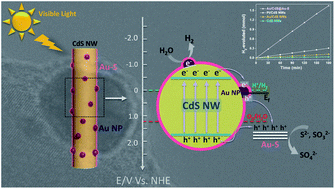Construction of a nanocavity structure with a carrier-selective layer for enhancement of photocatalytic hydrogen production performance†
Abstract
Efficient solar energy capture and utilization is of great importance in various photoenergy conversion systems, such as solar cells and photocatalysts. Herein, we reported a photocatalytic enhancement system by constructing a nanocavity structure with a carrier-selective layer. The photocatalytic hydrogen production activity is improved by ∼13.8 times in comparison to that of Au/CdS due to the construction of a nanocavity structure with a carrier-selective layer, in which the nanocavity structure is mainly used to enhance the utilization efficiency for solar light in the photocatalytic system. The Au–S layer on the one hand effectively transfers the holes, which extends the lifetime of the active species in the semiconductor photocatalyst to accelerate the hydrogen production reaction. On the other hand, it changes the electron transfer pathway between CdS and Au nanoparticles. This system achieved an optimal H2-evolution rate of 0.55 mmol h−1 under visible light irradiation, and its apparent quantum efficiency (AQE) reached 19.1% at 430 nm. As a novel strategy, our study may provide a new design protocol for highly efficient photocatalytic systems.

- This article is part of the themed collection: Sustainable Energy & Fuels Cover Art


 Please wait while we load your content...
Please wait while we load your content...